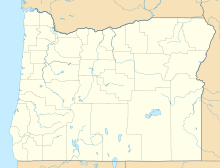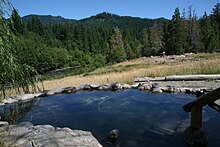| Breitenbush Hot Springs | |
|---|---|
 Breitenbush Hot Springs Sweat House in 1923 Breitenbush Hot Springs Sweat House in 1923 | |
| Location | near Detroit, Oregon |
| Coordinates | 44°46′59″N 121°58′40″W / 44.783061°N 121.9777805°W / 44.783061; -121.9777805 |
| Elevation | 2,225 |
| Type | geothermal |
| Discharge | (220±20 L/s) |
| Temperature | 356 °F (180 °C) to 150°F (65°C) |
 | |
Breitenbush Hot Springs, also known as Breitenbusher Hot Springs, is a thermal mineral spring system along the Breitenbush River near the historic town of Breitenbush, Oregon, United States.
History


The hot springs in this geothermal area were used for centuries by the Indigenous people in the region, the Kalapuya, Wasco, and Molalla, for medicinal and spiritual purposes. Settlers began using the springs in the 1840s.
In 1873, a Willamette Valley farmer John Minto, a Willamette Valley statesman and farmer began developing a transportation route over the Cascade Mountains, wrote in a 1903 memoire, that Henry States, Frank Cooper, and himself had named hot springs after meeting a one-armed hunter named John Breitenbush, who was camping near the hot springs. In 1938, a man named Frederick Breitenbusher claimed that this was his pioneer father, Lewis Breitenbusher. Since 1873, the shortened name Breitenbush rather than Breitenbusher has been used for the springs.
In 1897, John Hollingsworth began managing the hot springs and in 1904 the upper and lower pools became two separate soaking areas. In the same year a grant for the upper hot springs was issued to Claude Mansfield by president Theodore Roosevelt.
In the 1910s, a Salem resident, Mark Skiff, was issued a Forest Service permit to develop the lower hot springs into a commercial establishment, named Skiff's camp. The upper springs were purchased in 1927, by the Bruckman family who further developed the springs to include a large pool and local amenities. In the 1970s the upper and lower facilities were destroyed in a flood. In 1977, the upper springs were purchased by Alex Beamer, and later rebuilt into a retreat and conference center. The lower springs remain in a primitive state with the remains of the soaking pools as well as natural rock pools.
Water profile
The geothermally heated water emerges from over thirty springs at 356 °F (180 °C), and cool to between 198 °F (92 °C) and 150 °F (65 °C) at the surface. The mineral content includes analcime, anhydrite, calcite, calcium, chalcedony, lithium, magnesium, microcline, muscovite, sodium, sulfate, potassium, and quartz.
Geology
The Breitenbush hot springs geothermal area is located on the boundary between the Western Cascade late-Tertiary rocks and the High Cascade rocks which are younger in geological age. The Western Cascade rock formations include the pumice-rich, crystal-vitric Breitenbush Tuff, tuffaceous sandstone, the Detroit Beds, and mudflow breccia. The Breitenbush Tuff is covered by the basaltic lava and breccia of the Outerson Formation. Erosion has occurred in many of the volcanic landforms, but the residuum of the High Cascade volcanoes are still recognizable.
 Lower Breitenbush hot springs.
Lower Breitenbush hot springs.
Location
The springs are located in the Willamette National Forest. The Lower Breitenbush hot springs area us are on public land managed by the USDA Forest Service; and are not to be confused with the resort establishment, Breitenbush Hot Springs, where some of the upper hot springs are located on private property and are accessible only to paying guests of the commercial establishment.
See also
References
- ^ Field, Michelle. "Breitenbush Hot Springs". The Oregon Encyclopedia. Archived from the original on 18 May 2020. Retrieved 10 September 2020.
- ^ Berry, George W.; Grim, Paul J.; Ikelman, Joy A. (1980). Thermal Spring List for the United States. Boulder, Colorardo: National Oceanic and Atmospheric Administration.
- ^ "Lower Breitenbush Hot Springs - Cascade Mountains". Oregon Discovery. Archived from the original on 1 October 2020. Retrieved 10 September 2020.
- ^ Urness, Zach (30 August 2015). "Forgotten hot springs on Breitenbush could get facelift". Statesman Journal. Retrieved 11 September 2020.
- ^ "Breitenbush Hot Springs Retreat Center - Cascades". Oregon Discovery. Archived from the original on 1 October 2020. Retrieved 10 September 2020.
- Mariner, R. H.; Swanson, J. R.; Orris, G. J.; Presser, T. S.; Evans, W. C. "Chemical and Isotopic Data for Thermal Springs and Wells in Oregon". United States Department of the Interior, Geological Survey. Retrieved 10 September 2020.
- Ingebritsen, S. E.; Sherrod, D. R.; Mariner, R. H. (17 March 1989). "Heat Flow and Hydrothermal Circulation in the Cascade Range, North-Central Oregon". Science; published by: American Association for the Advancement of Science. 243 (4897): 1458–1462. Retrieved 11 September 2020.
- Hammond, Paul. "Geology of the Breitenbush Hot Springs area, Cascade Range, Oregon". Portland State University, Department of Geology. Archived from the original on 25 September 2020. Retrieved 11 September 2020.